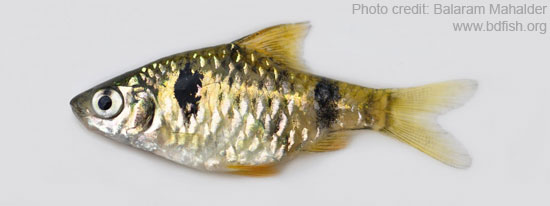
Systematic position
Phylum: Chordata
Class: Actinopterygii (Ray-finned fishes)
Order: Cypriniformes (Carps)
Family: Cyprinidae (Carps and minnows)
Genus: Puntius
Species: P. phutunio
Synonyms
Barbus phutunio (Hamilton, 1822)
Cyprinus phutunio Hamilton, 1822
Systomus leptosomus McClelland, 1839
Systomus phutunio (Hamilton, 1822)
Common/local names
English: Dwarf barb, Pigmy barb and Spottedsail barb.
Bangladesh: Phutani punti (ফুটানি পুঁটি)
India: Ngakha, Phutuni-pungti and Kudji-kerundi (Talwar and Jhingran, 1991).
Distribution: Bangladesh, India (Orissa, West Bengal, Assam and Goa), Myanmar and Pakistan (Talwar and Jhingran, 1991).
Conservation status: Not Threatened in Bangladesh (IUCN Bangladesh, 2000).
Morphology: Elevated body moderately compressed. Eyes large, mouth small, terminal and slightly oblique with no barbels. Upper jaw slightly longer. The last unbranched ray of dorsal fin is osseous, strong and serrated. Pelvics originated below dorsal and pectoral as long as head excluding snout.
Body greenish silvery. Silvery reflections on side of the scales and belly. Two vertically elongated bands present (one from back to middle of pectoral and another from back to posterior end of anal base. Light yellow color appears in both dorsal and pectoral during breeding season and pelvics and anal show orange in color.
Head 3.4-3.5 in standard, 4.4-4.7 in total length. Height 2.3-2.5 in standard, 3.0-3.2 in total length. Eye 2.8-3.0; snout 0.7; interorbital 1.3 (Rahman, 1989).

Fin formula:
D 10-11 (23)8; P 15; V 9; A 8(3/5); C 19 (Bhuiyan, 1964)
D ii-iii 8; A iii 5; P i 14; V i 8 (Talwar and Jhingran, 1991)
D. 10 (2/8); P1. 13-14; P2. 8; A. 7-8 (2-3/5) (Rahman, 1989 and 2005)
Maximum lengths: 7 cm (Bhuiyan, 1964), 3.5 cm (Talwar and Jhingran, 1991) and 4 cm (Rahman, 1989 and 2005).
Habitat: Rivers, streams, pools, beels and tanks of Dhaka and surrounding areas (Bhuiyan, 1964). In Bangladesh rivers, streams, beels ponds and pools are the common habitat. Besides it can also inhabit in muddy waters. Recorded from Chalan Beel (Galib et al., 2009).
Importance: Used as food fish in Bangladesh. Also important as aquarium fish (Bhuiyan, 1964).
_______________________________________________________
REFERENCES
Bhuiyan AL. 1964. Fishes of Dacca, Asiat. Soc. Pakistan, Pub. 1, No. 13, Dacca, pp. 38-39.
Galib SM, Samad MA, Mohsin ABM, Flowra FA and Alam MT. 2009 Present Status of Fishes in the Chalan Beel- the Largest Beel (Wetland) of Bangladesh, Int. J. Ani. Fish. Sci. 2(3):214-218.
Hamilton F. 1822 An account of the fishes found in the river Ganges and its branches. Edinburgh & London. An account of the fishes found in the river Ganges and its branches.: i-vii + 1-405, Pls. 1-39.
McClelland J. 1839. Indian Cyprinidae. Asiatic Researches v. 19 (pt 2): 217-471, Pls. 37-61.
Rahman AKA. 1989. Freshwater Fishes of Bangladesh, 1st edition, Zoological Society of Bangladesh, Department of Zoology, University of Dhaka, Dhaka-1000, p. 130.
Rahman AKA. 2005. Freshwater Fishes of Bangladesh, 2nd edition, Zoological Society of Bangladesh, Department of Zoology, University of Dhaka, Dhaka-1000, pp. 148-149.
Talwar PK and Jhingran AG. 1991. Inland Fishes of India and Adjacent Countries, Vol. I, Oxford & IBH Publishing Co. Pvt. Ltd. New Delhi-Calcutta, pp. 278-279.
Visited 1,562 times, 1 visits today | Have any fisheries relevant question?
